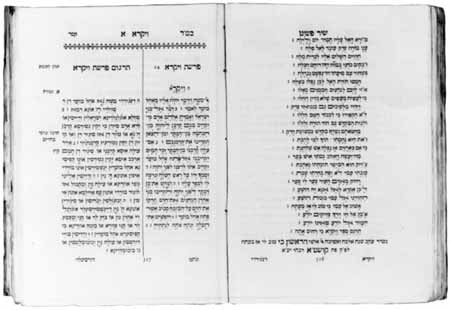The Book of the People of the Book: The Karaite Humash
During the nineteenth century, two editions of the Humash (Pentateuch) were printed in the same part of the world at about the same time. One is a splendid edition of the Five Books of Moses in Hebrew with a Turkish Tatar translation in parallel columns, published by the Karaite community in Ortakoi, a town near Constantinople, 1832-35. The excellent condition of the Library's copy serves to emphasize the sumptuousness of the edition — the paper, crisp and strong, of the finest linen; the Hebrew letters beautifully designed and expertly cut; the page design featuring wide margins.
The Karaites, B'nai Mikra (Children of Scripture), are a Jewish sect which had its beginnings in the eighth century. The sect's chief characteristic is that it accepts the authority of the Bible but rejects the Talmudic rabbinic tradition. At its beginnings, Karaism constituted a serious challenge to traditional rabbinic Judaism, but as time went on its attraction receded. its numbers remained small, concentrated in a few centers in Egypt, Turkey, Syria, the Crimea, and Lithuania. If the main body of Jews and the Karaites differed in matters of faith, they shared a common fate, until the incorporation of the Crimea and Lithuania into the Russian Empire at the end of the eighteenth century, when the situation began to change. In 1795, the Empress Catherine 11 permitted the Karaites to purchase land and relieved them of the double taxation imposed upon other Jews. In 1827, Karaites were exempted from the dreaded military draft, which plucked Jewish children from their families for twenty-five years and more of distant military service. It was obvious to the Karaites that it would be to their advantage to distance themselves as far as possible from other Jews. In memoranda to the Czarist government the Karaites consequently stressed their fundamental difference from other Jews, in belief and in history, arguing that they were not Jews but "Russian Karaites of the Old Testament Faith," which became their official designation. In 1840 they were granted equality of status with the Muslems, and in 1863 with native Russians.
During the first decades of the nineteenth century, Russian Karaites increased in number as well as in economic well-being, status, and self esteem. What better way to mark and celebrate their ascent than to publish a splendid edition of the Torah by and for the "Children of Scripture." Appearing at the height of the Karaites' campaign to distance themselves from the Jews, the publication would serve that end as well. The Tatar translation was obviously for Karaites only. The group of Karaite scholars who edited the text and prepared the translation was headed by Abraham Firkowitz (1786-1874), an antiquarian scholar and bibliographer who as a leader of the separation campaign wrote messages to the Czarist government and collected documents to bolster the Karaite position. On occasion he was not above doctoring the written record to support the Karaite claims. This Humash then is both an aesthetic creation and a political statement, declaring to the Czarist authorities: We share little with the Jews, no, not even the Bible. They have theirs, and we, like you Christians, have ours, this, our own Karaite Humash.
 |
Sources: Abraham J. Karp, From the Ends of the Earth: Judaic Treasures of the Library of Congress, (DC: Library of Congress, 1991).


